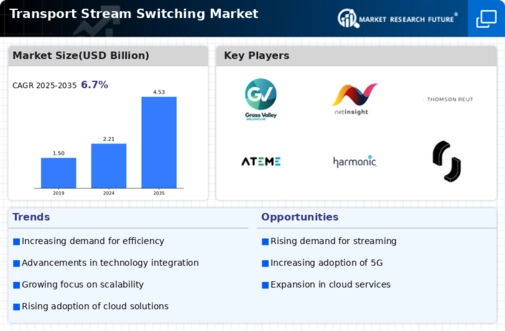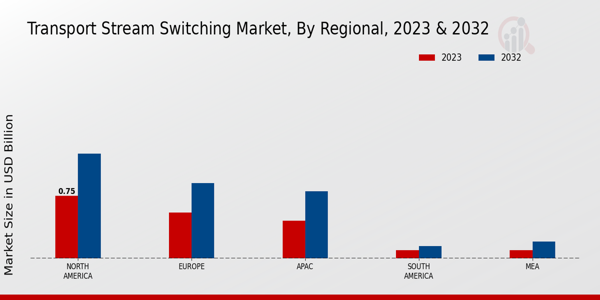Growth of OTT Platforms
The proliferation of Over-The-Top (OTT) platforms is a key driver of the Global Transport Stream Switching Market Industry. As more consumers turn to OTT services for their entertainment needs, the demand for efficient transport stream switching solutions escalates. These platforms require robust infrastructure to manage diverse content delivery methods, ensuring high-quality streaming experiences. The anticipated compound annual growth rate of 6.75% from 2025 to 2035 reflects the increasing reliance on transport stream switching technologies to support the growing number of OTT services. This trend highlights the importance of adaptable switching solutions in meeting the evolving demands of content delivery.
Market Growth Projections
The Global Transport Stream Switching Market Industry is poised for substantial growth, with projections indicating a market size of 4.53 USD Billion by 2035. This anticipated growth reflects the increasing demand for efficient transport stream management solutions across various sectors, including broadcasting and telecommunications. The market is expected to experience a compound annual growth rate of 6.75% from 2025 to 2035, driven by technological advancements and the rising need for high-quality content delivery. These projections underscore the importance of strategic investments in transport stream switching technologies to capitalize on emerging opportunities in the global market.
Regulatory Compliance and Standards
Regulatory compliance and adherence to industry standards are crucial factors shaping the Global Transport Stream Switching Market Industry. Governments and regulatory bodies establish guidelines to ensure the quality and reliability of broadcast services. Compliance with these regulations necessitates the implementation of advanced transport stream switching technologies, which can adapt to changing standards. This requirement drives investment in innovative solutions that enhance operational capabilities. As the industry navigates these regulatory landscapes, the demand for compliant switching technologies is expected to rise, further propelling market growth in the coming years.
Increasing Adoption of IP-Based Broadcasting
The shift towards IP-based broadcasting systems is transforming the Global Transport Stream Switching Market Industry. This transition allows for greater flexibility and scalability in content delivery, enabling broadcasters to manage multiple transport streams more effectively. The growing preference for IP-based solutions is driven by their ability to integrate with existing infrastructures and reduce operational costs. As broadcasters seek to enhance their service offerings, the adoption of IP-based transport stream switching technologies is likely to accelerate. This trend not only supports the current market growth but also positions the industry for future advancements.
Rising Demand for High-Quality Video Streaming
The Global Transport Stream Switching Market Industry experiences a surge in demand for high-quality video streaming services. As consumers increasingly prefer on-demand content, service providers are compelled to enhance their streaming capabilities. This trend is evidenced by the projected market value of 2.21 USD Billion in 2024, indicating a robust growth trajectory. The need for seamless switching between different transport streams to ensure uninterrupted viewing experiences is paramount. Consequently, advancements in transport stream switching technology are likely to play a pivotal role in meeting consumer expectations and maintaining competitive advantage in the market.
Technological Advancements in Broadcast Infrastructure
Technological innovations in broadcast infrastructure significantly influence the Global Transport Stream Switching Market Industry. The integration of advanced switching technologies facilitates efficient management of multiple transport streams, thereby enhancing overall operational efficiency. For instance, the adoption of software-defined networking and cloud-based solutions allows broadcasters to streamline their workflows and reduce latency. As the industry evolves, these advancements are expected to contribute to the market's growth, with projections indicating a market size of 4.53 USD Billion by 2035. This evolution underscores the necessity for broadcasters to invest in modern switching solutions to remain competitive.























Leave a Comment